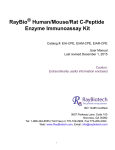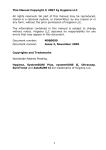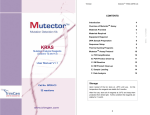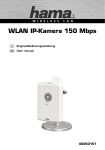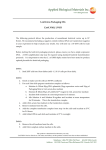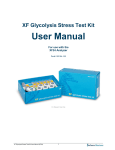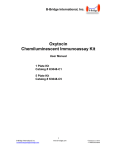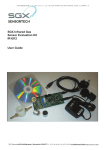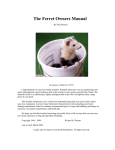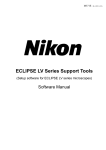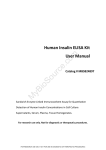Download Insulin
Transcript
MAGLUMI Insulin(CLIA) 130205002M Shenzhen New Industries Biomedical Engineering Co., Ltd 4F,Wearnes Tech Bldg, Science&Industry Park, Nanshan,Shenzhen, China 518057 Tel. + 86 755 26508518 Fax.+ 86 755 26508339 1. INTENDED USE The kit has been designed for the quantitative determination of Insulin in human serum. The method can be used for samples over the range of 0-200μIU/ml. The test has to be performed on the Maglumi fully auto analyzer (Including Maglumi 1000, Maglumi 2000, Maglumi 2000 plus). 100 Lotus Global Co., Ltd 15 Alexandra Road London UK NW8 0DP Tel. + 44-20-75868010 Fax.+ 44-20-79006187 FO R PROFESSIONAL USE ONLY Store at 2...8 °C COMPLETELY READ THE INSTRUCTIONS BEFORE PROCEEDING en SYMBOLS USED ON LABELS Authorized Representative in Europe Manufacturer Attention. See Instructions For Use Contents of kit In vitro diagnostic medical device (In vitro diagnostic use) Lot number 2. SUMMARY AND EXPLANATION OF THE TEST Human insulin is a polypeptide hormone originating in the beta cells of the pancreas and serving as a principal regulator for the storage and production of carbohydrates. Its secretion is normally stimulated by increases in the amount of glucose in circulation. This leads to higher insulin levels and more rapid tissue assimilation of glucose — followed by a decline in the insulin level as the glucose level subsides. In a number of conditions, notably insulinoma and diabetes, this relationship is impaired. Insulin tends to circulate at inappropriately high levels in patients with insulin-secreting pancreatic tumors; such tumors can thus be a cause of hypoglycemia. Accordingly, insulin immunoassays - used sometimes in connection with provocative doses of tolbutamide or calcium - play an essential role in the identification (and localization) of insulinomas. The finding of fasting hypoglycemia in association with an inappropriately high serum insulin concentration is considered diagnostic. Insulin levels do not figure in the subclassification of diabetes worked out by the National Diabetes Data Group. Nevertheless, when obtained in the course of a glucose tolerance test, they appear to be of some prognostic value in predicting the benefits of insulin therapy and the likelihood of progression to insulin-dependence and the complications (such as retinopathy) characteristic of diabetes. The application of insulin immunoassay to patients already undergoing insulin therapy is complicated by the fact that such therapy typically leads to the formation of anti-insulin antibodies capable of interfering with the assay. Some investigators have sought therefore to measure insulin in urine, or in serum samples subjected to column chromatography or PEG precipitation. But the measurement of "free" insulin remains of limited interest as a technique for monitoring insulin therapy in the absence of statistics establishing therapeutic or toxic ranges. So far it appears that glucose control in diabetics cannot in general be achieved by normalizing the insulin profile. Nor is it known at what point abnormally high insulin levels become dangerous. 3. PRINCIPLE OF THE TEST Sandwich immunoluminometric assay: Use an anti-Insulin monoclonal antibody to label ABEI, and use another monoclonal antibody to label FITC. Sample, Calibrators or Control, ABEI Label, FITC Label and nano magnetic microbeads coated with sheep anti-FITC are mixed thoroughly and incubated at 37℃, forming a sandwich; after sediment in a magnetic field, decant the supernatant, then cycle washing it for 1 time. Subsequently, the starter reagents are added and a flash chemiluminescent reaction is initiated. The light signal is measured by a photomultiplier as RLU within 3 seconds and is proportional to the concentration of Insulin present in controls or samples. 4. KIT COMPONENTS 4.1 Material supplies Reagent Integral for 100 determinations Catalogue Code Nano magnetic microbeads: Tris buffer, 1.2%(w/v), 0.2%NaN3, coated with sheep anti- FITC polyclonal Expiry date (Use by…) Temperature limitation ( store at 2...8 °C) Calibrator low 2.5ml Calibrator high 2.5ml ABEI Label: anti-Insulin monoclonal antibody labeled ABEI, contains BSA, 0.2%NaN3. FITC Label: anti-Insulin monoclonal antibody labeled Number of tests Keep away from sunlight 2.5ml antibody. FITC, contains BSA, 0.2%NaN3. 10.5ml 10.5ml Please Rehydrate the calibrator before using! Accessories required but not provided Maglumi Reaction module Maglumi Starter kit 1+2 Biological risks Maglumi Light check Maglumi Wash /System Liquid 4.2 Preparation of the Reagent Integral Before the sealing is removed, gentle and careful horizontal shaking of the Reagent Integral is essential (avoid foam formation!) Remove the sealing and turn the small wheel of the magnetic microbeads compartment to and fro, 130205002M-v1.0-EN 1/2 until the colour of the suspension has changed into brown. Place the Integral 10. into the reagent area and let it stand there for 30 mins. During this time, the z magnetic z microbeads are automatically agitated and completely resuspended. Do not interchange Nano Magnetic Microbeads from different reagents! 4.3 Storage of the Reagents Integral Sealed:Stored at 2-8℃ until the expiry date. z z Opened : Stable for 4 weeks. After this period, it is still possible to keep on using the Reagent Integral provided that the controls are found within the expected ranges. Keep upright for storage. z Keep away from direct sunlight. z 5. Origin of Calibrators. Calibrators in the Reagent Kit are from Sigma. Biological root: synthetic materials, processed by HPLC purification, with a purity ≥99%. No HBsAg, anti-HCV, and anti-HIV is found. 6. Calibration 6.1 2 point recalibration Via the measurement of calibrators, the predefined master curve is adjusted (recalibrated) to a new, instrument-specific measurement level with each calibration. 6.2 Frequency of Recalibration After each exchange of lot (Reagent Integral or Starter Reagents). z Every week and/or each time a new Integral is used z (recommendation). after each servicing of the Maglumi Fully Auto analyzer. z If controls are beyond the expected range. z 7. Sample Collection, Material and Storage Collect samples using standard procedures. Sample material: serum. z Store at 2-8℃: 24 hours. z For longer storage periods: freeze to below - 20℃. z Avoid repeated freezing and thawing cycles. z Stored samples should be thoroughly mixed prior to use (Vortex z mixer). *Vacuum tubes z (a) Blank tubes are recommended type for collecting samples. (b) If plasma sample is needed, EDTA tube is conformed has no effect on the results RLUs. (c) Liquaemin Sodium tube is found to increase the sample RLU and cause test results deviation. (d) Please ask SNIBE for advice if special additive must be used in the sample blood. z 8. z z z z WARNING AND PRECAUTIONS FOR USERS For use in IN-VITRO diagnostic procedures only. Do not interchange reagents from different lots. Do not use kit components beyond their labeled expiry date. All samples, biological reagents and materials used in the assay must be considered potentially able to transmit infectious agents. They should therefore be disposed of in accordance with the prevailing regulations and guidelines of the agencies holding jurisdiction over the laboratory, and the regulations of each country. Disposable materials must be incinerated; liquid waste must be decontaminated with sodium hypochlorite at a final concentration of 5% for at least half an hour. Any materials to be reused must be autoclaved using an overkill approach(USP 24,2000,p.2143). A minimum of one hour at 121℃ is usually considered adequate, though the users must check the effectiveness of their decontamination cycle by initially validating it and routinely using biological indicators. The calibrators in this kit are prepared from bovine serum products. However, because no test method can offer complete assurance that HIV, Hepatitis B Virus or other infectious agents are absent, these reagents should be considered a potential biohazard and handled with the same precautions as applied to any serum or plasma specimen 9. Test Procedure To ensure proper test performance, strictly adhere to the operating instructions of the Maglumi Fully Auto analyzer. Each test parameter is identified via a RFID tag on the Reagent Integral. For further information please refer to the Maglumi Fully Auto Operator’s Manual. 40μl Sample, calibrator or controls +80μl ABEI Label +80μl FITC Label +20μl Nano magnetic microbeads 30 min Incubation 400μl each time Cycle washing 3s Measurement 130205002M-v1.0-EN Quality Control Observe quality control guidelines for medical laboratories. Use suitable controls for in-house quality control. 11 Results 11.1 Calculation of Results The analyzer automatically calculates the Insulin concentration in z each sample by means of a calibration curve which is generated by a 2-point calibration master curve procedure. The results are expressed in μIU/ml. For further information please refer to the Maglumi Fully Auto Operator’s Manual. 11.2 Interpretation of Results Reference values: 4.03 μIU/ml– 23.46 μIU/ml (before meal). Results may differ between laboratories due to variations in z population and test method. Each laboratory should establish its own reference range. 12. Limitations of the procedure 12.1 A skillful technique and strict adherence to the instructions are necessary to z obtain reliable results. Bacterial contamination of samples or repeated freeze-thaw cycles may affect the test results. Assay results should be utilized in conjunction with other clinical and laboratory data to assist the clinician in making individual patient management decisions. 12.2 HAMA Patient samples containing human anti-mouse antibodies (HAMA) may give falsely elevated or decreased values. Although HAMA-neutralising agents are added, extremely high HAMA serum concentrations may occasionally influence results. 12.3 High-Dose Hook No high-dose hook effect was seen for Insulin concentrations up to 2000 μIU/ml. ABEI is a synthetic organic compound, not a substance in serum, so there is no interferon which can affect the result; If the operation is in accordance with the user’s manual, and the control is within the range of the user’s manual, there is no need of performing a validation assay. 13. Performance Characteristics 13.1 Accuracy Consider calibrator high of known concentration as a sample, dilute it by 1:2 ratio with diluent, and measure its diluted concentration for 10 times. Then calculate the recovery of measured concentration and expected concentration. The recovery should be within 90% -110%. 13.2 Precision Intra-assay coefficient of variation was evaluated on Calibrator High repeatedly measured 10 times in the same assay, calculating their coefficient of variation, the results should ≤10%. Inter-assay coefficient of variation was evaluated on three batches of kit, repeatedly measured 10 times of Calibrator High, calculating three batches of kit for Calibrator High between the measured values of the coefficients of variation, the results should ≤15%. 13.3 Sensitivity The sensitivity is defined as the concentration of Insulin equivalent to the mean RLU of 20 replicates of the zero standard plus two standard deviations corresponding to the concentration from the standard curve. The sensitivity is typically less than 3.00μIU/ml. 13.4 Specificity The result of Proinsulin assay should accord with the following description: When Proinsulin=200μIU/ml, the detection results of Insulin <6μIU/ml. 13.5 Linearity Conduct a logarithmic transform to the RLU value and concentration value of 6 standards. After a double logarithmic fitting, the absolute value of its linearity should exceed 0.9800. 14. 1. References Binder C & Faber OK. Residual Beta-cell Function and Its Metabolic Consequences.Diabetes 1978;27(Suppl 1):226-229 2. Blix PM et al.Urinary C-Peptide: An Indicator of β-Cell Secretion under Different Metabolic Conditions.J Clin Endocrinol Metab 1982;54:574-580 3. Horwitz DL, Starr Jl,Mako ME et al. Proinsulin,insulin,and C-Peptide Concentrations in Human Portal and Peripheral Blood. J Clin Invest 1975;55:1278-1283 2/2


